Click on images to enlarge

infestation (Photo: Forest and Kim Starr, USGS)

habit (Photo: Sheldon Navie)

habit in fruit (Photo: Sheldon Navie)

older stem with scattered thorns (Photo: Sheldon Navie)
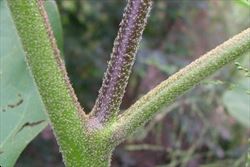
close-up of younger stem, with relatively dense covering of star-shaped hairs (Photo: Sheldon Navie)
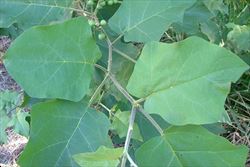
leaves (Photo: Sheldon Navie)

deeply-lobed leaf on younger plant (Photo: Sheldon Navie)

almost entire leaf blade on older plant (Photo: Sheldon Navie)

densely hairy young flower clusters (Photo: Sheldon Navie)
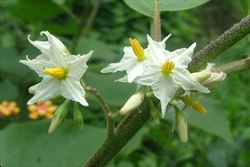
flower clusters (Photo: Sheldon Navie)

close-up of star-shaped flower (Photo: Sheldon Navie)
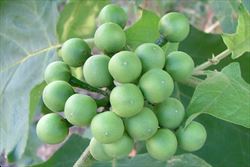
cluster of immature fruit (Photo: Sheldon Navie)

close-up of mature fruit (Photo: Sheldon Navie)

close-up of seeds (Photo: Steve Hurst at USDA PLANTS Database)
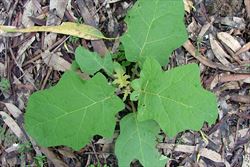
young plant (Photo: Sheldon Navie)
Scientific Name
Solanum torvum Sw.
Synonyms
Solanum largiflorum C.T. White
Family
Solanaceae
Common Names
devil's fig, gully-bean, pea eggplant, platebrush, prickly solanum, shoo-shoo bush, susumber, terongan, Thai eggplant, turkey berry, turkeyberry, wild egg plant
Origin
Native to southern Mexico, Central America (i.e. Belize, Costa Rica, Guatemala, Honduras, Nicaragua and Panama), the Caribbean and tropical South America (i.e. French Guiana, Guyana, Venezuela, Brazil, Colombia and Ecuador).
Cultivation
Devil's fig (Solanum torvum) is sometimes cultivated in tropical regions for its edible fruit.
Naturalised Distribution
Widely naturalised in the warmer coastal regions of northern and eastern Australia (i.e. in the northern parts of the Northern Territory and in northern and eastern Queensland). Possibly also naturalised in the coastal districts of northern New South Wales.
Also naturalised overseas in tropical Africa, Asia, south-eastern USA (i.e. Florida and Alabama), Papua New Guinea and on several Pacific islands (e.g. American Samoa, Western Samoa, Fiji, Hawaii, New Caledonia, Niue, Palau and Tonga).
Habitat
A weed of closed forests, forest margins, waterways (i.e. riparian areas), plantation crops, roadsides, pastures, disturbed sites and waste areas.
Habit
An upright (i.e. erect) shrub or small tree usually growing 0.8-3 m tall, but occasionally reaching up to 5 m in height.
Distinguishing Features
- an upright shrub or small tree usually growing 0.8-3 m tall.
- its younger stems are green or purplish and densely covered is small star-shaped hairs.
- its relatively large leaves (7.5-25 cm long) have entire to shallowly-lobed margins and whitish undersides.
- its white star-shaped flowers (about 25 mm across) are arranged in branched clusters containing 15-100 flowers.
- its rounded berries (12-17 mm across) turn from green to yellow or yellowish-green as they mature.
Stems and Leaves
The younger stems are green or purplish in colour and sometimes sparsely covered in prickles or thorns (3-7 mm long). They are also densely covered is small star-shaped (i.e. stellate) hairs. Older stems become brown or greenish-brown and eventually lose their covering of hairs.
The relatively large, alternately arranged, leaves (7.5-25 cm long and 4-15 cm wide) are borne on stalks (i.e. petioles) 1-5 cm long. These leaves are broadly egg-shaped in outline (i.e. ovate) or almost rounded (i.e. orbicular) in shape with entire to shallowly-lobed margins. However, the leaves on younger plants may be more deeply-lobed (i.e. pinnatisect). The leaf tips and lobes, when present, may be rounded or pointed (i.e. they have obtuse to acute apices). The leaves of adult plants do not have any prickles, however seedlings and young plants may have some small prickles on their upper surfaces. Both leaf surfaces, but particularly the whitish undersides, are covered in star-shaped (i.e. stellate) hairs.
Flowers and Fruit
The star-shaped flowers (about 25 mm across) are arranged in branched clusters (i.e. paniculate or corymbose clusters) on a main stalk (i.e. peduncle) 2-17 mm long. These clusters contain 15-100 flowers, each being borne on a stalk (i.e. pedicel) 6-10 mm long. The flowers have five white petals (9-12 mm long), that are fused together at the base, and five densely hairy green sepals (2.5-6 mm long). They also have five stamens with yellow anthers (6-7.5 mm long) and an ovary topped with a style (8-10.5 mm long) and stigma.
The rounded (i.e. globular) berries (12-17 mm across) turn from green to yellow or yellowish-green as they mature (eventually brownish). They contain numerous white, pale yellow or dull brown flattened seeds (1.5-2.5 mm long).
Reproduction and Dispersal
This species reproduces by seed, which are mainly spread by fruit-eating (i.e. frugivorous birds) that eat the berries.
Environmental Impact
Devil's fig (Solanum torvum) is regarded as an environmental weed in Queensland, and was recently listed as a priority environmental weed in at least one Natural Resource Management region.
Legislation
Not declared or considered noxious by any state government authorities.
Similar Species
Devil's fig (Solanum torvum) is very similar to giant devil's fig (Solanum chrysotrichum). These two sepcies can be distinguished by the following differences:
- devil's fig (Solanum torvum) has moderately large leaves (usually 5-21 cm long) with several (about seven) slight to moderately deep lobes. Its relatively small white flowers (up to 25 mm across) have small sepals (3-4 mm long). The dense star-shaped (i.e. stellate) hairs on its new growth are whitish or yellowish in colour.
- giant devil's fig (Solanum chrysotrichum) has moderately large to very large leaves (usually 9-35 cm long) with several to numerous (seven to thirteen) moderately deep to very deep lobes. Its relatively large white flowers (30-40 mm across) have relatively large sepals (7-10 mm long). The dense star-shaped (i.e. stellate) hairs on its new growth are reddish in colour.
Note: For a more in-depth key to distinguish between all of the solanums (Solanum spp.) present in eastern Australia, see the online key to the Solanum Species of Eastern Australia at http://delta-intkey.com/solanum/index.htm.

